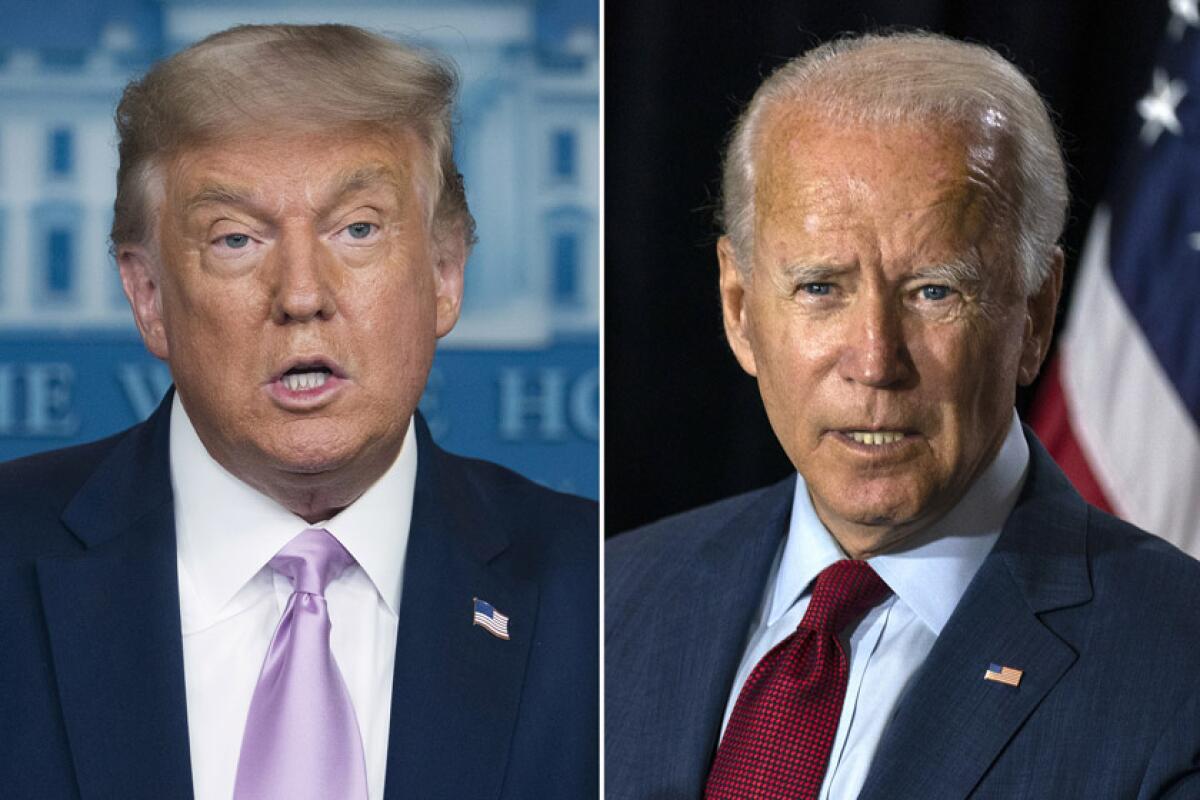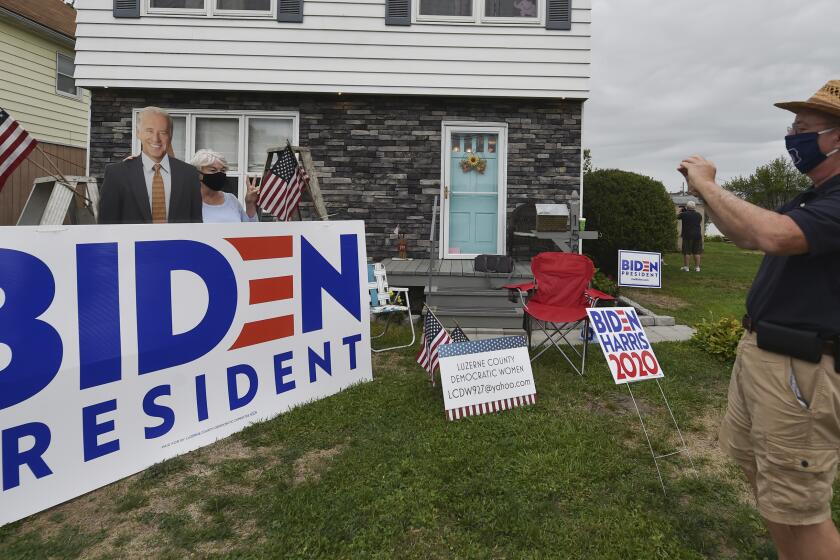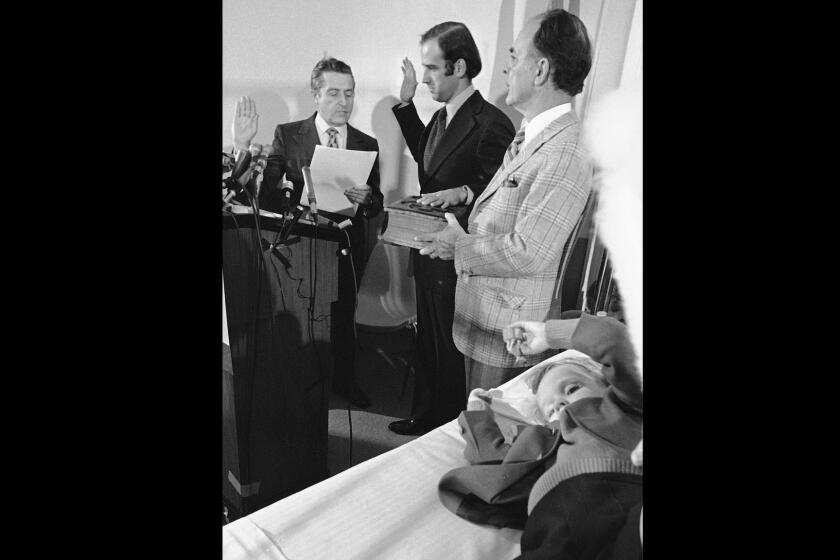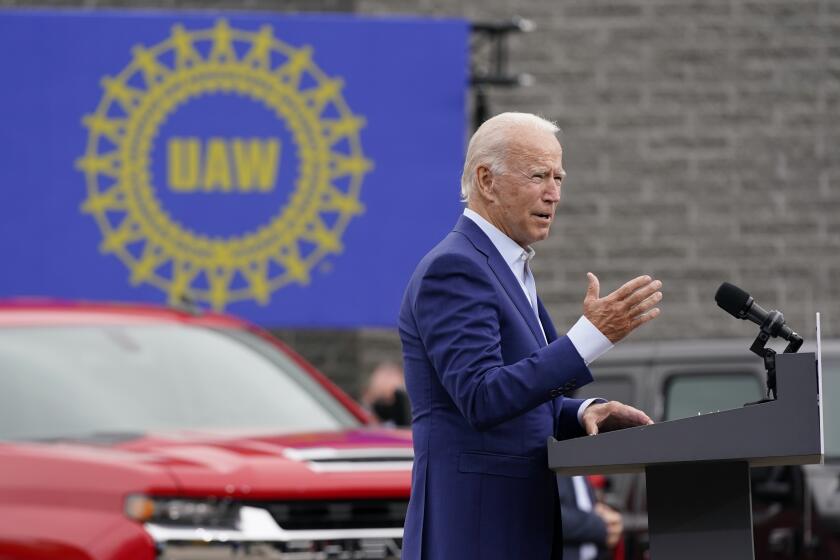Poll highlights key barriers for Trump and Biden in final weeks before election

- Share via
WASHINGTON — As the presidential race moves into its final seven weeks, with former Vice President Joe Biden holding a lead that remains steady but not conclusive, he and President Trump face contrasting challenges, new data from a USC Dornsife poll show.
Biden has largely succeeded in uniting his fellow Democrats. But as he tries to build a broad coalition that would include a significant number of independents and moderate Republicans — a step that could lock down key states — he faces resistance on ideology. Independents and voters who lean Republican, groups that make up a large share of the remaining swing voters, judge Biden to be considerably more liberal than themselves, the poll finds.
Trump faces a different challenge: Not only is he behind, but a slice of his potential supporters are iffy about voting, the poll finds. At the same time, the main issue he has pushed in recent weeks — law and order — appears to have salience mostly with people who already strongly support him.
President Trump’s talk of a Democratic war on the suburbs is not winning him votes in the actual suburbs. But it may help him in blue-collar areas that proved decisive in 2016.
Registered voters who solidly back Trump and those who solidly back Biden report a similar likelihood of voting, about 95% on average. The president’s problem comes with those who say they only lean toward voting for him. They average a 75% likelihood, the poll finds, compared with 92% for those who lean to Biden.
Those weak Trump supporters are also slightly more doubtful that their ballots will be counted — a worry that the poll indicates may be discouraging their likelihood of voting. Trump’s warnings about rigged elections and vote fraud, which have been replete with false statements, may have heightened those concerns, unintentionally deterring some of his supporters.
Biden leads Trump nationwide by 9 points, 51% to 42%, the USC Dornsife poll finds. Biden’s margin has shrunk slightly since last week, a change that could reflect a tightening of the race but is small enough that it may simply be random fluctuation in the poll’s daily tracking.
As he seeks to close the gap, Trump faces a daunting reality: A large share of the electorate has tuned him out. Nearly 6 in 10 voters have an unfavorable view of him, and about half say their view is “extremely unfavorable.”
Among undecided voters — a small share of the electorate — 70% view Trump unfavorably, as do about three-quarters of those who say they voted for a third-party candidate in 2016. About 15% of people who say they voted for Trump in 2016 view him unfavorably today.
Views of Biden are closely divided, 50% favorable and 47% unfavorable, the poll found. In contrast to Trump, only about a third of voters say their view of Biden is “extremely unfavorable.” Independents have a net negative view of both candidates.
Among some voter groups, unusually large shares say their view of Trump is extremely unfavorable: 79% of Black voters, for example, 64% of city dwellers, 56% of Latinas, and 51% of millennials and younger voters.
Trump has made little pretense of fishing in those waters. Instead, his campaign has focused on driving up the vote among groups that already support him, focusing on identifying and turning out people who didn’t vote in 2016.
That’s not an impossible strategy: Key states such as Pennsylvania, Wisconsin and Michigan have large numbers of white residents living in rural and exurban areas who didn’t vote in the last presidential election.
The poll, however, points to a major difficulty with that strategy: Trump hasn’t had much success in making his law-and-order message connect with voters who weren’t already committed to him.
The poll listed nine issues the candidates have talked about and asked respondents to pick the one that is most important in determining their vote. The results indicate that Trump has made law and order top of mind for many of his supporters. Law enforcement and criminal justice came in second place among Trump voters, although well behind jobs and the economy.
Among voters overall, however, law enforcement ranked fourth — behind not only the economy, but also “uniting the country and healing racial divisions,” a main theme for Biden’s campaign and a top concern for Biden supporters, and “response to the coronavirus.”
Other issues took a back seat, notably immigration, which played a major role in the 2016 campaign, and climate change, although the current data was collected before Trump’s visit to California this week renewed attention on that issue.
“So far, few voters are focused on climate change as a deciding issue in the campaign. It will be interesting to see if that changes as the campaign progresses,” said Jill Darling, director of the survey.
Trump makes a short visit to California for a fire briefing as Biden attacks him for not taking climate change seriously as a threat.
Making matters worse for Trump, voters overall think Biden would handle law enforcement issues better than the president, although Biden’s margin here is small, 52% to 48%. That’s consistent with other surveys and voter interviews that have found that many believe Trump is worsening the problems of urban unrest and violence, not making them better.
“Trump is campaigning heavily on an issue on which Biden actually has an advantage,” said Bob Shrum, the veteran Democratic strategist who directs the USC Center for the Political Future, which co-sponsors the poll. “That’s an unusual strategy,” he added.
Biden had a wider margin of approval, however, on handling COVID-19, 57% to 43%. Trump narrowly bested Biden on jobs and the economy, 52% to 48%.
Economic issues could still provide a path forward for Trump, especially if public concern about COVID starts to wane this fall, said Mike Murphy, the veteran Republican strategist and Trump critic who co-directs the USC center.
But “Trump can’t help getting in his own way” by constantly raising personal grievances and other side issues, Murphy said.
The group of Trump voters who say they are less than certain to vote cite law enforcement as a top issue less often than firmer Trump supporters do.
Nearly one-third of Trump’s voters have a below average probability of casting a ballot. They are more likely to be women and non-college-educated, and motivated by opposition to Biden more than support for Trump. Among them, law enforcement was roughly tied as a priority with uniting the country and healthcare — an issue that was high on the list for Biden supporters, but scarcely mentioned by Trump’s solid backers.
Healthcare also ranks as one of the top issues among the small group of voters who remain undecided; by 55% to 45%, they say Biden would be better able to handle it.
Biden has emphasized his ability to unify the country — an issue on which voters give him a clear advantage, 61% to 39%. Undecided voters gave Biden a 78% to 22% edge on handling that task.
Among Biden’s supporters, one-third chose uniting the country and healing racial divisions as the most important issue for their vote, ranking ahead even of responding to COVID-19, which just over 1 in 5 picked.
Making empathy central to his campaign, Joe Biden seeks a contrast with President Trump.
For Biden, the theme of uniting the country and healing its divisions provides several benefits: It connects with his long-standing image as a person who can forge compromises; it avoids potential splits within his party that might surface if the debate focused more intensely on healthcare, immigration or climate change; and it also more broadly sidesteps ideological debate.
That last point is crucial because independents and those leaning Republican see a wide ideological gap between themselves and the Democratic candidate.
Asked to rank themselves and the candidates on an ideological scale from 0 to 100, with 0 being the most liberal and 100 the most conservative, voters overall rated themselves somewhat right of center, at 56. They rated Trump as more conservative, at 69, and placed Biden significantly further to the left, at 35.
Independents gave themselves an average rating of 52 and placed Trump fairly close to themselves ideologically, at 55. They saw Biden as further to the left, at 39. Those who described themselves as only leaning to the Republicans rated themselves at 67. Like the independents, they rated Trump as fairly close to them ideologically, at 71, and saw Biden as further to the left, at 23.
Voters tend to pick the candidate they see as ideologically closer to them, although that’s not always the case: In 2012, for example, surveys showed that voters, on average, saw the Republican candidate, Mitt Romney, as closer to them ideologically than President Obama, who won reelection nonetheless.
Biden has made a persistent effort to appeal to formerly Republican voters in suburban regions and white, blue-collar voters in states like Pennsylvania, Michigan and Wisconsin.
Four years ago, victories in Pennsylvania, Michigan and Wisconsin put Trump in the White House. The three states are once again at center stage.
The campaign’s focus on those more conservative voters has dismayed some of his party’s progressive stalwarts, including Sen. Bernie Sanders of Vermont. The senator’s former campaign manager, Faiz Shakir, gave a statement last week to the Washington Post saying that Sanders was urging “a stronger outreach to young people, the Latino community and the progressive movement.”
The USC Dornsife poll, a joint project of the university’s Center for Economic and Social Research and the Center for the Political Future, tracks the views of a panel of more than 8,000 eligible voters. The poll surveys each panel member every 14 days. The current results are based on responses from 5,272 panel members, of whom 4,580 are registered voters.
Results are weighted to reflect U.S. Census Bureau figures for demographic characteristics including gender, race and education. The estimated error range for the poll’s full sample is roughly 2 percentage points in either direction.
A complete description of the poll’s methodology, along with the text of the questions asked and the full data tables, is available on the USC Dornsife website.
More to Read
Get the L.A. Times Politics newsletter
Deeply reported insights into legislation, politics and policy from Sacramento, Washington and beyond. In your inbox three times per week.
You may occasionally receive promotional content from the Los Angeles Times.















